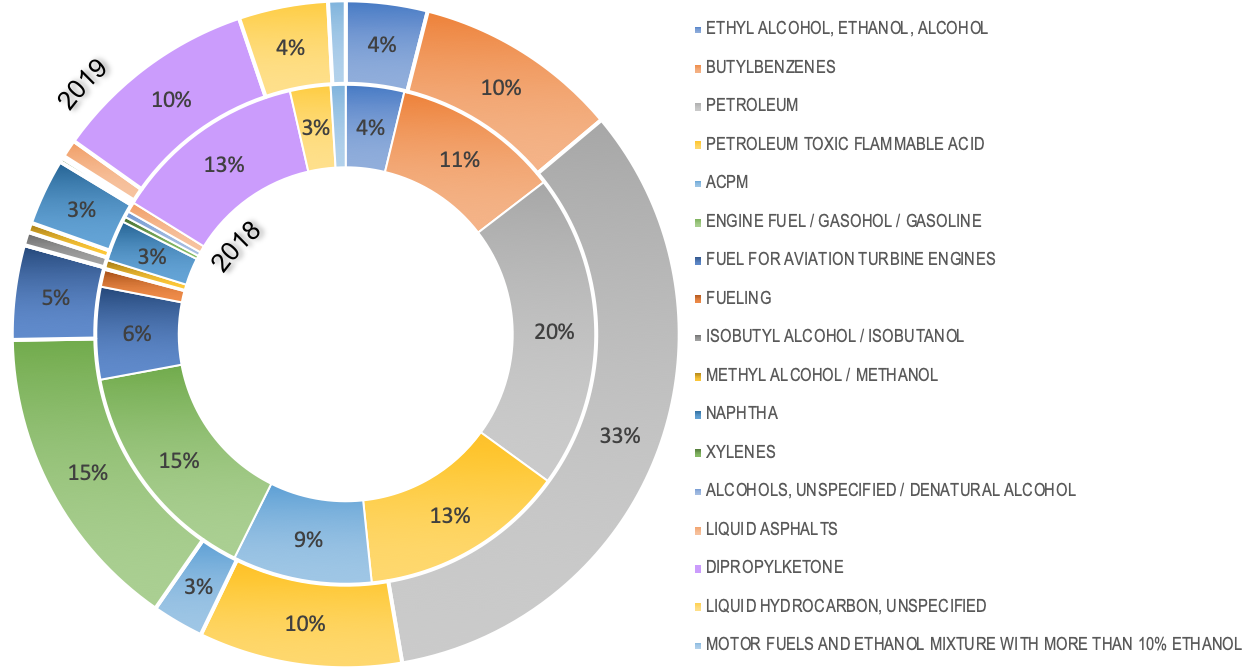In Colombia, transportation of hazardous chemicals is frequently carried out using trucks that commute throughout the country. In particular, liquid hydrocarbons such as crude oil, gasoline and diesel stand out due for their high frequency of transportation and the large volumes. The land transport of these substances entails an inherent danger and risk for drivers and for the communities and ecosystem surrounding the road corridors. In order to evaluate the possible risks and environmental impacts that an incident involving the spill of dangerous chemical substances would entail (particularly for liquid hydrocarbons), a computer-based assessment was carried out using open software tools. Initially, an analysis was done to identify the hydrocarbons that represent the greatest risk, as well as the road corridors with the highest accident rates. This was done by using a potential risk estimation using a novel methodology involving quantitative assessment based upon the Globally Harmonized System of Classification and Labelling of Chemicals (GHS) (Narváez et al., 2020). Subsequently, the most appropriate open software tool (ALOHA®) was selected to implement risk studies in the transportation sector (Jones et al., 2013). Despite its versatility, ALOHA® only allows modelling pure substances, and a methodology was developed to select suitable surrogate compounds to described the studied hydrocarbon mixtures. Once selected, a scenario analysis was carried out to model an incident involving the release of fuel in a high-accident rate corridor in the country. The effect of using surrogate substances and substances with user-defined properties was studied. Liquid release, vapor cloud dispersion, and fire events were also evaluated. This made it possible to evaluate affected areas, risks of chemical exposure and radiation damage, as well as to estimate midpoint environmental impacts based upon reported emission factors (Bare, 2012).
Based upon historical records of transported hazardous materials, it was found that 95% corresponded to hydrocarbons including crude oil, fuels, solvents and petrochemical feedstocks. Among these, around 30% corresponds to crude oil mainly transported from the east part of the country to the main refineries in north and central regions, whereas ~15% corresponded to gasoline. After application of a reported methodology for the preliminary evaluation of inherent hazard and potential risk, it was determined that gasoline and crude oil were also the substances that represent the greatest potential impact on the environment and the greatest risk in the social dimension. Thereby, crude oil and gasoline were used in the subsequent risk assessment.
Once the study case products were identified, the surrogate substances for the modelling in ALOHA® were selected. After minimization of the difference in the properties of interest (i.e. those used in spill, heavy-gas dispersion and pool fire models), it was found that local crude oil (i.e. Castilla crude oil) and gasoline could be adequately represented by using Cyclohexane, Ethylbenzene or n-Octane as surrogates. An alternative approach was also used by creating a new component in the data base with the properties of the studied hydrocarbons, but major issues occurred because ALOHA® do not allow to modify vapor pressure nor density of the materials. This generated a misprediction of spilled volume and of the evaporation rates during loss-of-containment events. This has been overlooked in previous studies and it is considered a major source of uncertainty when using ALOHA® for risk assessment. Finally, geographical information and data from a real truck accident was used to assess the goodness of the model. It was found that the software enabled to accurately predict some of impacts that occurred in the studied event. This indicate that the developed methodology and the use of ALOHA were suitable for conducting preliminary risk assessments and to develop contingency plans in the management of accidents involving transportation of liquid hydrocarbons.
References
Narváez, P. C., Serna, J., Orjuela, A., Camargo, M. (2020) Sustainability assessment for chemical product and process design during early design stages. In: Towards Sustainable Chemical Processes- Applications of Sustainability Assessment and Analysis, Design and Optimization, and Hybridization and Modularization. P. 3-41. https://doi.org/10.1016/B978-0-12-818376-2.00001-6
Jones, R., W. Lehr, D. Simecek-Beatty, R. Michael Reynolds. 2013. ALOHA® (Areal Locations of Hazardous Atmospheres) 5.4.4: Technical Documentation. U. S. Dept. of Commerce, NOAA. Technical Memorandum NOS OR&R 43. Seattle, WA: Emergency Response Division, NOAA. 96.
Bare, J. C. 2012. Tool for the Reduction and Assessment of Chemical and Other Environmental Impacts (TRACI), Version 2.1 - User’s Manual; EPA/600/R-12/554
Figure 1. Distribution of total number of transportations of liquid fuels in Colombia for 2018 and 2019


